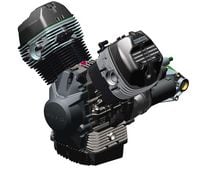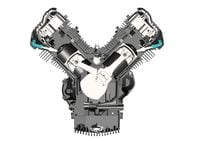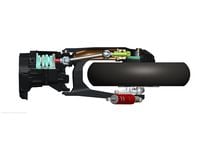Moto Guzzi, in an effort to modernize the “small-block” engine, has committed a thorough redesign that also retains the old engine’s distinctive shape and, probably, allows it to be built on existing tooling.
Displacement, that’s obvious. The 84mm by 77mm bore and stroke result in a displacement of 853cc, against an 80mm bore and 74mm stroke in the V7’s 744cc package. So Guzzi could have simply bored the engine but went through the trouble to add stroke to maintain good low-rpm and midrange power, although the new configuration is slightly more oversquare than before. Guzzi has obviously changed the crankshaft but also claims to have revised the oiling system to include oil-squirts for the pistons, a new crankcase-ventilation system, and revised pressure components.
The pistons are new, too, and not just because they’re bigger around. Until the V9, the small-block Guzzi engine used so-called Heron heads. Heron heads have no combustion chamber in the head itself, which is machined flat and carries the two valves (in the V7’s case) side by side, faces flat to the machined surface of the head; there’s no relative angle between. Such a design simplifies the valvetrain, which can be straight from the cam follower through the rocker arm right to the valve. In a Heron head, the combustion chamber is actually part of the piston, with each engine design using a Heron head having more or less of a depression in the head to create the desired compression ratio. Heron heads have gradually fallen out of favor with the proliferation of four-valve heads and as engineers find new ways to shape conventional combustion chambers in the heads.
For the V9, Guzzi has moved to a roughly hemispherical head design, still with two valves and a single spark plug each. While the single cam is still down in the cylinder vee, and the pushrods in the same plane as before, new rocker arms operate the newly splayed valves. Adjustment is via threaded adjusters at the rocker arm, similar to the V7’s setup.
This newer design allows a raised compression ratio—now 10.5:1 instead of 9.6:1—which boosts power and efficiency. And heat, which is why Guzzi changed the oiling system with an eye toward moving more heat out of the combustion chambers. Power is up to 55 hp at 6,250 rpm, from a claimed 48 hp at 6,200 rpm in the V7 II. Torque is up from 44.2 pound-feet to 45.7. Considering that new Euro 4 emissions limits are in effect for the V9, it’s likely that the combined benefits of the new heads and increased displacement were partially spent meeting the new regs, and that a Euro 3-compliant V9 would be steamier still. Guzzi went to the effort of fitting an oil pump that takes less power to run as well as revised crankcase breathing to reduce pumping losses.
Following this engine, which does rate as largely new, is a new clutch and greatly revised six-speed gearbox. As before, the clutch is a single-plate dry type but it’s bigger and given new actuation hardware to make the lever pull easier. In addition, the linkless shaft final drive has a second universal joint near the ring and pinion gear set to allow for a wider rear wheel without having the shaft housing at the back of the engine be any wider; so the swingarm half holding the shaft is angled instead of leading straight back off the engine.
A revised single-throttle-body injection system works with the now-requisite oxygen sensors and twin catalysts to scrub the exhaust clean. But Guzzi also took the opportunity to add two-level traction control and an innovative, albeit optional MG-MP multimedia platform that links the bike’s systems to your smart phone.
Moto Guzzi has played up the “authenticity” of its newest urban machine, drawing on the marque’s 95-year history, but in that effort almost managed to cover up the fact that the small-block engine has received a greater number of improvements in one go than it’s had since it was introduced in 1977.










/cloudfront-us-east-1.images.arcpublishing.com/octane/FONCOZ2FSM7A7XSJOSSTV7IWE4.jpg)





/cloudfront-us-east-1.images.arcpublishing.com/octane/MUQLOVLL2ZDGFH25ILABNBXKTI.jpg)
/cloudfront-us-east-1.images.arcpublishing.com/octane/TNOU5DNE2BC57MFPMGN2EIDXAM.jpg)
/cloudfront-us-east-1.images.arcpublishing.com/octane/GTCXACQGJ5HAPDTGWUQKDEH44E.jpg)
/cloudfront-us-east-1.images.arcpublishing.com/octane/S35YGSEMEZB4BLTDJTSZPF4GLA.jpg)
/cloudfront-us-east-1.images.arcpublishing.com/octane/5UOT6HPX2JFMRJAX6EH45AR4MQ.jpg)
/cloudfront-us-east-1.images.arcpublishing.com/octane/OKWOJWAKP5EP3OACCRRWPCIX2Q.jpg)
/cloudfront-us-east-1.images.arcpublishing.com/octane/2WF3SCE3NFBQXLDNJM7KMXA45E.jpg)
/cloudfront-us-east-1.images.arcpublishing.com/octane/G4MG6OUCJNBSHIS2MVVOTPX65E.jpg)
/cloudfront-us-east-1.images.arcpublishing.com/octane/IIGGWFOTOJGB7DB6DGBXCCMTDY.jpg)
/cloudfront-us-east-1.images.arcpublishing.com/octane/QSTCM6AVEZA5JJBUXNIQ3DSOF4.jpg)
/cloudfront-us-east-1.images.arcpublishing.com/octane/U4I7G625B5DMLF2DVIJDFZVV6M.jpg)
/cloudfront-us-east-1.images.arcpublishing.com/octane/B6XD6LS6IVCQPIU6HXDJSM3FHY.jpg)
/cloudfront-us-east-1.images.arcpublishing.com/octane/ICL63FEDDRDTTMINYICCEYGMDA.jpg)
/cloudfront-us-east-1.images.arcpublishing.com/octane/FCGZHQXRBZFLBAPC5SDIQLVF4I.jpg)
/cloudfront-us-east-1.images.arcpublishing.com/octane/WNOB6LDOIFFHJKPSVIWDYUGOPM.jpg)

/cloudfront-us-east-1.images.arcpublishing.com/octane/X33NU3E525ECRHXLNUJN2FTRKI.jpg)
/cloudfront-us-east-1.images.arcpublishing.com/octane/6KKT5NNL2JAVBOXMZYS5ZO76YA.jpg)
/cloudfront-us-east-1.images.arcpublishing.com/octane/J5RKG5O455GMPGQRF2OG6LRT7A.jpg)
/cloudfront-us-east-1.images.arcpublishing.com/octane/GX2CIZKQVRH2TATDM26KFG2DAE.jpg)
/cloudfront-us-east-1.images.arcpublishing.com/octane/ZWIDYSAKQZHD5BHREMQILXJCGM.jpg)
/cloudfront-us-east-1.images.arcpublishing.com/octane/CYUHJZCTSJCH3MRAQEIKXK7SCQ.jpg)
/cloudfront-us-east-1.images.arcpublishing.com/octane/LKOFINY56FCXJCANJ5M7ZDQUBY.jpg)
/cloudfront-us-east-1.images.arcpublishing.com/octane/4NBPDACMWJH63JQYJVK3QRBDZI.jpg)